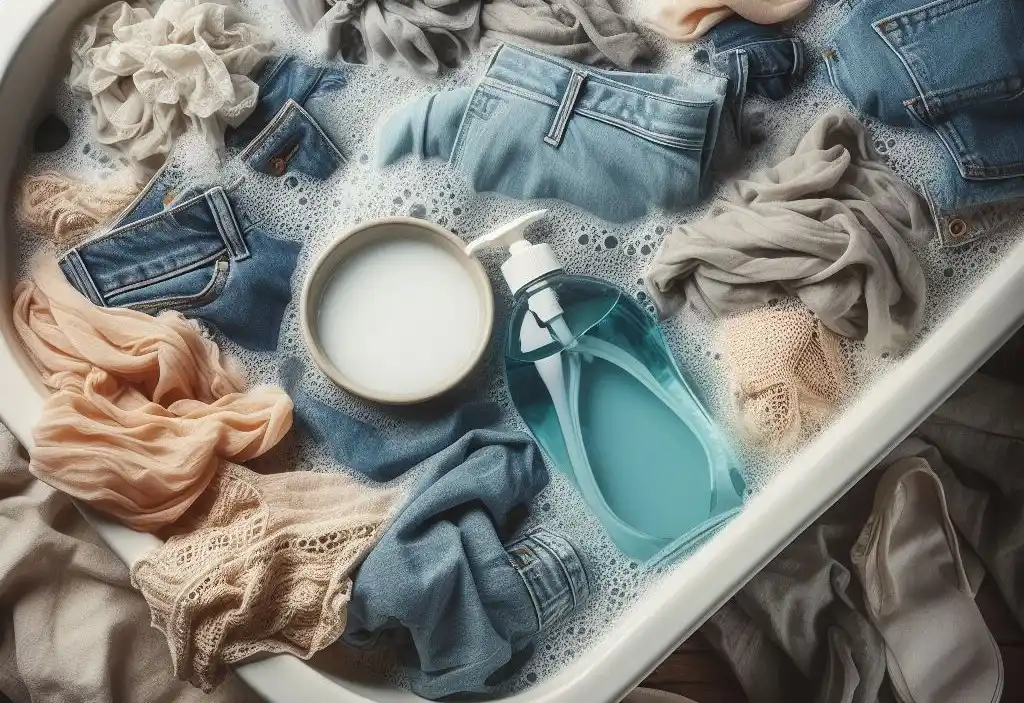How to Wash Chemicals Out of New Clothes: The Ultimate Guide to Remove Chemical Odor
Have you ever bought a new piece of clothing and noticed a strong chemical odor? That unpleasant smell is often due to the different chemicals and treatments used during manufacturing and shipping. While convenient, these chemicals can cause skin irritation, respiratory issues, and other health problems in sensitive individuals.
The good news is that you can take steps to remove these toxic substances from brand-new apparel. In this comprehensive guide, you’ll learn How to Wash Chemicals Out of New Clothes and how to effectively wash pesticides, formaldehyde, odorants, and other harmful residue out of recently purchased garments.
Table of Contents
Why It’s Important to Wash New Clothes Before Wearing
- Many clothes contain traces of formaldehyde, a known human carcinogen used to prevent wrinkling. Exposure can cause headaches, asthma attacks, and contact dermatitis.
- Cheap clothing from overseas is often treated with pesticides to guard against insects during transit. These chemicals linger and get absorbed through your skin.
- Odorants and fragrances give clothes that “new” smell but can trigger reactions in those with chemical sensitivities.
- Clothing dyed with azo-based fabric dyes can expose you to cancer-causing compounds and should be washed before wearing.
- Unless specified as organic, conventionally grown cotton harbors high concentrations of pesticides and other residues from crop treatment.
Washing garments multiple times helps remove residual dye, softeners, metals, flame retardants, and other chemical additives from the manufacturing process. This makes them safer to wear next to your skin.
Let’s explore some best practices for tackling stubborn sizing, formaldehyde, and other toxic substances that linger in new apparel and textiles.
Determine If the Clothing Is Machine Washable
- Check the attached care label to see if machine washing is recommended or if dry cleaning is required.
- Natural fibers like cotton, linen, silk, and wool are typically washable.
- Manmade fabrics like polyester, nylon, acrylic, and olefin need mild detergent on a gentle/cold setting.
- Rayon and viscose should be washed in cold water to prevent shrinkage and maintain shape.
Supplies You’ll Need to Wash Chemicals Out of New Clothes
- Mild or sensitive skin laundry detergent
- White vinegar – cuts through residues and acts as a deodorizer
- Baking soda – Removes odors, softens fabric
- Oxygen/color-safe bleach (optional)
- Mesh garment bags – protect delicate fabrics
- Garment rack or hanger for air-drying items
Step-by-step Instructions For How to Wash Chemicals Out of New Clothes

Follow these methods whether hand-washing delicate items or machine-washing durable textiles to get clothing fresh and safe to wear.
1. Shake Out and Air Out the Garment
After removing the wrapping and tags, shake the item outdoors to release any loose dye, dust, or chemical treatment. Hanging on a line or rack enables fresh air to help evaporate and air out some of the odor and sizing.
2. Check for Colorfastness
Make sure the dyes are set and won’t bleed when washed. Rub a small, inconspicuous area like an inside seam or hem it with a wet white cloth. If color transfers to the white cloth, the dye isn’t set so wash in cold water only. If no color bleeds, you can launder normally with warm or hot water.
3. Pretreat Any Stained or Heavily Soiled Areas
Use a small amount of liquid detergent, bar soap, or stain removal stick to rub fabric against itself to help break down oils, dyes, or other concentrated substances.
4. Hand Wash First If the Item Is Labeled Dry Clean Only
For garments too delicate for the washer, fill a sink or tub with cool water and add a small amount of mild detergent. Allow to soak then gently move the garment around to release residues. Drain then refill the water to rinse. Roll the item in a towel to remove moisture then lay flat on a drying rack or hanger.
5. Sort Clothes by Color Before Machine Washing
Wash dark colors separately from light colors, whites, and bright prints. Use mesh bags for delicates, underwires, sequins, etc. Zip zippers, fasten hooks, tie drawstrings to prevent snagging and tangling.
6. Wash Using Mild Detergent and Hot Water
The hottest water recommended for the fabric will help eliminate chemical residue, odors, and dye more effectively. Avoid using conventional fabric softener which leaves a chemical coating.
7. Add Vinegar or Baking Soda to the Wash Cycle
White vinegar helps neutralize odors, soften fabric, and remove soap residue while baking soda deodorizes and gently scrubs without fading darks. For heavily soiled clothes, let soak for 30 minutes before washing.
8. Use Oxygen Bleach on Whites If Needed
For dingy whites and light fabrics, additive an oxygen bleach that uses hydrogen peroxide to lift stains. Unlike chlorine bleach, it won’t damage or yellow delicate fabrics. Skip this step for darks and bright colors as it can fade over time.
9. Rinse Twice on the Gentle Cycle
Double rinsing ensures all traces of detergent, bleach, and other wash additives are removed leaving fabric fresh, residue-free, and soft.
10. Inspect After Drying
Check for stains or new areas of color bleeding. For hand wash items check for shrinkage or damage. If issues persist, consult a fabricare specialist for the next steps.
11. Steam or Iron If Needed
For wrinkle-free clothing or harsh creases, use an iron on the appropriate heat setting for the fabric. Or use a garment steamer to relax the fibers. Check for dye bleeding on hidden seams first.
Pro Tip: For used clothing or vintage items, add 1⁄2 cup baking soda to the wash to eliminate odors from perfume, smoke, etc.
Alternative Ways to Remove Strong Chemical Smells from Clothes

If the odor persists after multiple regular washes, try these special methods to remove irritating fragrances and finishes:
- Soak in vinegar water – Mix 1 cup white vinegar per gallon of cold water. Soak garment 1-6 hours then launder as usual.
- Baking soda rub – Sprinkle baking soda directly on fabric. Gently rub into areas with scent. Shake off excess then wash. The grains help lift and absorb odorants from fabric.
- Diluted hydrogen peroxide – Mix one part peroxide with 4 parts water in a spray bottle. Lightly spritz clothing and let sit for 1 hour before regular washing.
- Activated charcoal – Place a charcoal pack or loose charcoal pieces in a sealed bin or bag with the garment for 24-48 hours absorbing odor. Charcoal can be reused until saturated.
- Enzyme cleaner – This pet urine remover works to break down organic matter and chemicals that cause odor. Check that the formula is safe for your fabric first.
- Ozone treatment – Ozone gas permanently removes odors without leaving a scent. Find a local dry cleaner that offers this treatment if home methods are ineffective.
While not a chemical smell, mothball odor is tricky to remove from clothing. It requires a soak with lemon juice or wiping fabric down with rubbing alcohol before washing.
Test these homemade remedies on hidden seams first since extended soaking or vigorous rubbing could damage delicate fabrics.
Should You Dry Clean Instead of Machine Washing Clothing?
Some nice clothing like tailored suits, cocktail dresses, and formalwear are labeled “Dry Clean Only.” So is this method better at removing manufacturing chemicals versus home washing?
Pros of Dry Cleaning
- Cleans without risk of shrinking wool, silk, and other “dry clean only” textiles
- Won’t damage beading, sequins, and delicate embellishments
- Removes oil and grease stains better than water
- No chance of dye transfer onto other clothes
Cons of Dry Cleaning
- Most facilities still use perc (tetrachloroethylene), a probable human carcinogen banned in CA
- Residual perc can remain in the garment and be absorbed into the skin
- Adds a chemical solvent smell requiring extra airing out
The GreenEarth process uses liquid silicone instead of perc but availability is limited.
If you are able to wash at home first, dry cleaning may only be needed for stubborn oily stains instead of removing manufacturing residue. Check garment tags closely for exceptions like wool suits or cocktail gowns too delicate for a machine.
How to Shop for Less Toxic and Skin-Safe Clothing
While washing new apparel helps, the best solution is buying clothes and fabrics made without the use of hazardous chemicals in the first place.
Here’s what to look for when sourcing greener, non-toxic clothing:
Seek Out Organic Fabrics
Cotton, linen, silk, and other materials grown without pesticides, GMOs or toxic dye contain far fewer chemical residues. This makes them safer for those with sensitivities.
Check for Trusted Eco-Labels Like GOTS and Oeko-Tex
Global Organic Textile Standard (GOTS) certification tracks the processing of textiles from farm to finished product using organic methods.
Oeko-Tex Standard 100 indicates clothes and fabrics tested free from over 100 known harmful substances like pesticides, heavy metals, formaldehyde, and other allergens.
Favor Brands That Offer Transparency
Responsible companies disclose factory locations, show chemical testing results, and audit supply chains rather than hiding behind trade secrecy laws.
Seek Clothing Made Locally In Your Country
Items produced domestically using strict environmental regulations tend to utilize greener chemistry and enforce wage standards versus imports.
While costlier than fast fashion, non-toxic organic apparel lasts longer both structurally and in style. The health and environmental benefits outweigh the extra expense over time.
FAQs About Removing Chemicals from Clothes
Can I just keep washing an item multiple times until the residue is gone?
You should wash or dry clean new clothing 2-3 extra times to ensure all traces of toxic additives are removed. If the stubborn smell persists after that using alternative methods, and further cleaning attempts could risk damaging the garment.
Is it mandatory to wash clothing before wearing it?
It’s not legally required, but highly advisable to launder new apparel before skin contact based on testing showing the presence of skin-sensitizing and hazardous substances. Only you can determine your chemical sensitivity threshold.
How many times should you wash new clothes?
Wash 3-5 times minimum to eliminate common chemicals. First, 1-2 washes remove surface residues. Subsequent washing draws out chemicals embedded deep within the fabric itself. Also, wash used clothing obtained secondhand before wearing.
Do organic clothes still contain harmful chemicals?
Certified organic fabrics themselves do not contain synthetic chemicals by regulated definition. However, some facilities use toxic cleaning agents, moth repellents, or fragrances when storing textiles which then require washing to remove.
Is hand washing or machine washing better for new clothes?
Hand washing allows you to control water temperature, gently agitate fabrics, and avoid friction damage from machine mechanisms. Machine washing eliminates more residue in less time yet risks tearing delicate fabrics. Choose a method based on care instructions and if needed, alternate hand wash and gentle machine cycles.
Can dry cleaning damage clothing over time?
The heat and agitation of machines could accelerate the pilling or fraying of fabrics. More significantly, chemical solvents like PERC penetrate fabric and weaken fibers and seams despite providing a pristine appearance short term. Minimize dry cleaning especially for heirloom textiles and vintage garments whenever possible.
Conclusion: Why You Should Always Wash New Clothing
While not required by clothing makers, laundering purchased apparel before wearing is a smart preventative measure. The multiple washes and rinses help strip away pesticide residues, release formaldehyde, remove irritating fragrances, and ensure dyes won’t bleed onto your skin.
Carefully reading garment labels and investing in non-toxic organic textiles means less hazardous exposure over time. But when in doubt, lathering up any new clothes with mild detergent helps lift away lingering chemicals from mass production.
Your skin will thank you anytime you wash potential allergens, carcinogens, and respiratory toxins out of clothing before allowing next-to-skin contact during wear. Take a little extra effort to purify new garments for cleaner and healthier fashion.








